Enjoy our triplist below! For our tour
description, itinerary, past triplists, dates, fees, and more,
please visit our TOUR PAGE.
Click on the link at right to see this
triplist in printable PDF format with media only on
page 1.
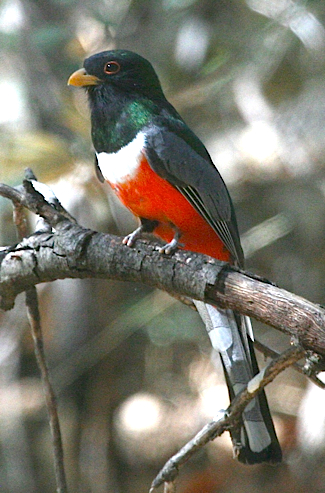
The lone member of
the tropical Trogon family to occur regularly in the US, the
beautiful Elegant Trogon is understandably high on the
target list for most birders visiting Arizona for the first
time. (Photo by guide Dave Stejskal)
It was another terrific survey tour to the birdiest spots in
beautiful Southeast Arizona, but we could have done without
that annoying wind during the last half of the tour! I've
never had four days straight of howling wind like that on this
tour before, but, somehow, we managed to do just great with
the birds during our ten days together, and had some fun along
the way.
The trip started out great with a first afternoon on Mt.
Lemmon just north of Tucson, and then a productive morning in
some Tucson lowland hotspots. Red-faced Warbler and
Zone-tailed Hawk up high on the first afternoon, Harris's Hawk
& Tropical Kingbirds at Sweetwater Wetlands in town, and
then cooperative Gilded Flickers in the Tucson Mountains all
had us feeling pretty good before we left town. A quick stop
at Willcox gave us our first taste of the wind that was to
come, but seeing those breeding-plumaged American Avocets and
Wilson's Phalaropes, along with surprise rarities like
White-rumped and Stilt sandpipers, made us forget the wind for
a while.
Then it was on to the lofty Chiricahuas, just starting to
recover from the devastating Horseshoe II fire of last summer.
Though the habitats up high were patchy, they were still
productive and gave us memorable looks of Mexican Chickadee,
Olive Warbler, and many others. At the lower elevations, in
the lush and mostly unburned Cave Creek Canyon, we thrilled at
point-blank Elegant Trogon, Sulphur-bellied Flycatcher,
Montezuma Quail, Painted Redstart, and countless others. The
dry habitats outside the canyons yielded surprise Baltimore
& Orchard orioles, along with Greater Roadrunner, Crissal
Thrasher, Juniper Titmouse, Black-chinned Sparrow, and others.
And it was in the Chiricahuas where we really started our
owling in earnest. Our evenings out together produced great
views of Elf, Whiskered and Western screech-owls, Common
Poorwill, and Mexican Whip-poor-will. We enjoyed scope views
of cooperative Northern Pygmy-Owl during the day to round out
our nightbirds during our stay here.
The Huachucas, also just recovering from a major fire last
summer, were more of a challenge for us. It was here that our
confrontation with the wind started. But, despite the howling
wind, we did just great! Greater Pewee and Buff-breasted
Flycatcher up high in Carr Canyon showed themselves nicely for
the group, as did a sleepy, day-roosting Spotted Owl in Miller
Canyon - we're lucky it was hanging out so low in the canyon!
And a detour on our way to the Huachucas from the Chiricahuas
via Willcox brought us great views of a surprise lifer for a
few of us in the group - Arizona's 6th ever Hudsonian Godwit!
Continuing west through the Sonoita Grasslands and Patagonia,
along lush Sonoita Creek, our good fortune continued with
wonderful first-time views of Gray Hawk & Thick-billed
Kingbird, while a vigil at the Paton's feeders in Patagonia
yielded views of a striking Violet-crowned Hummingbird.
Another morning in the area gave us a relatively easy
Five-striped Sparrow without a hike in the heat! What a break
we got! And while working our way northward to Tucson on the
last day, we found what was arguably the bird of the trip - a
surprise Plain-capped Starthroat!
What a fantastic way to finish up a great trip!
Thanks to each of you for joining me on this birding
adventure to my home state - it's a region of the world that I
really love, as you could probably tell. You all were terrific
in enduring the howling wind during the last half of the tour,
but I guess that's easier to do when you're seeing wonderful
birds in a beautiful setting. Have a wonderful summer at home
or wherever you find yourself and I hope to see each of you
again on another birding tour someplace new!
--Dave
For more information about this tour, including future
departures, visit our website at www.fieldguides.com.
And to see this same triplist online, go to https://fieldguides.com/triplists/arz12bLIST.pdf
and you will find the list in its entirety.
KEYS FOR THIS LIST
One of the following keys may be shown in brackets for
individual species as appropriate: * = heard only, I =
introduced, E = endemic, N = nesting, a = austral migrant, b =
boreal migrant
Anatidae (Ducks, Geese, and Waterfowl)
BLACK-BELLIED WHISTLING-DUCK (Dendrocygna autumnalis)
GADWALL (Anas strepera) [b]
MALLARD (NORTHERN)
(Anas platyrhynchos platyrhynchos)
MALLARD (MEXICAN)
(Anas platyrhynchos diazi)
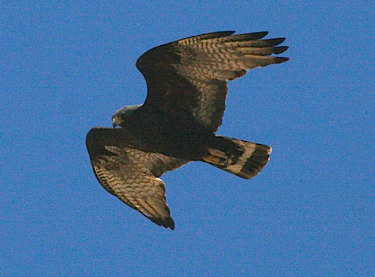
Zone-tailed Hawks
can be easy to overlook given their resemblance to Turkey
Vultures in flight, but when they get this close, there's
no mistaking them! (Photo by guide Dave Stejskal)
BLUE-WINGED TEAL (Anas discors) [b]
CINNAMON TEAL
(Anas cyanoptera) [b]
NORTHERN SHOVELER
(Anas clypeata) [b]
GREEN-WINGED TEAL
(Anas crecca) [b]
LESSER SCAUP
(Aythya affinis) [b]
RUDDY DUCK
(Oxyura jamaicensis)
Odontophoridae (New World Quail)
SCALED QUAIL (Callipepla squamata)
GAMBEL'S QUAIL
(Callipepla gambelii) [N]
MONTEZUMA QUAIL
(Cyrtonyx montezumae)
Phasianidae (Pheasants, Grouse, and
Allies)
WILD TURKEY (Meleagris gallopavo) [I]
Podicipedidae (Grebes)
LEAST GREBE (Tachybaptus dominicus)
PIED-BILLED GREBE
(Podilymbus podiceps)
EARED GREBE
(Podiceps nigricollis) [b]
Phalacrocoracidae (Cormorants and Shags)
DOUBLE-CRESTED CORMORANT (Phalacrocorax auritus) [b]
Pelecanidae (Pelicans)
AMERICAN WHITE PELICAN (Pelecanus erythrorhynchos) [b]
Ardeidae (Herons, Egrets, and Bitterns)
GREAT BLUE HERON (Ardea herodias) [N]

The recent fires
in southeast Arizona have created lots of good habitat for
Arizona Woodpeckers to forage in, and their numbers have
increased locally as a consequence. (Photo by guide Dave
Stejskal)
GREAT EGRET (Ardea alba)
[b]
GREEN HERON
(Butorides virescens)
BLACK-CROWNED
NIGHT-HERON (Nycticorax
nycticorax) [b]
Threskiornithidae (Ibises and Spoonbills)
WHITE-FACED IBIS (Plegadis chihi) [b]
Cathartidae (New World Vultures)
BLACK VULTURE (Coragyps atratus)
TURKEY VULTURE
(Cathartes aura)
Accipitridae (Hawks, Eagles, and Kites)
HARRIS'S HAWK (Parabuteo unicinctus)
GRAY HAWK (Buteo nitidus) [N]
SWAINSON'S HAWK
(Buteo swainsoni)
ZONE-TAILED HAWK
(Buteo albonotatus)
RED-TAILED HAWK
(Buteo jamaicensis)
Falconidae (Falcons and Caracaras)
AMERICAN KESTREL (Falco sparverius)
Rallidae (Rails, Gallinules, and Coots)
COMMON GALLINULE (Gallinula galeata)
AMERICAN COOT
(Fulica americana)
Charadriidae (Plovers and Lapwings)
SNOWY PLOVER (Charadrius nivosus) [b]
SEMIPALMATED
PLOVER (Charadrius
semipalmatus) [b]
KILLDEER (Charadrius vociferus)
Recurvirostridae (Stilts and Avocets)
BLACK-NECKED STILT (Himantopus mexicanus)
AMERICAN AVOCET
(Recurvirostra americana) [N]
Scolopacidae (Sandpipers and Allies)
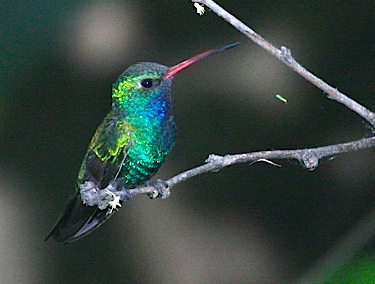
The lovely
Broad-billed Hummingbird is especially common around the
Patagonia area. (Photo by guide Dave Stejskal)
SPOTTED SANDPIPER (Actitis macularius) [b]
GREATER YELLOWLEGS
(Tringa melanoleuca)
[b]
LONG-BILLED CURLEW
(Numenius americanus) [b]
HUDSONIAN GODWIT
(Limosa haemastica)
[b]
MARBLED GODWIT
(Limosa fedoa) [b]
WHITE-RUMPED
SANDPIPER (Calidris
fuscicollis) [b]
BAIRD'S SANDPIPER
(Calidris bairdii) [b]
STILT SANDPIPER
(Calidris himantopus) [b]
LONG-BILLED
DOWITCHER (Limnodromus
scolopaceus) [b]
WILSON'S PHALAROPE
(Phalaropus tricolor) [b]
RED-NECKED
PHALAROPE (Phalaropus lobatus)
[b]
Laridae (Gulls, Terns, and Skimmers)
FRANKLIN'S GULL (Leucophaeus pipixcan) [b]
RING-BILLED GULL
(Larus delawarensis) [b]
CALIFORNIA GULL
(Larus californicus) [b]
Columbidae (Pigeons and Doves)
ROCK PIGEON (Columba livia) [I]
BAND-TAILED PIGEON
(Patagioenas fasciata)
EURASIAN
COLLARED-DOVE (Streptopelia
decaocto) [I]
WHITE-WINGED DOVE
(Zenaida asiatica)
MOURNING DOVE
(Zenaida macroura)
INCA DOVE (Columbina inca)
COMMON GROUND-DOVE
(Columbina passerina)
Cuculidae (Cuckoos)
GREATER ROADRUNNER (Geococcyx californianus)
Strigidae (Owls)
FLAMMULATED OWL (Otus flammeolus) [*]
WESTERN
SCREECH-OWL (Megascops
kennicottii)
WHISKERED
SCREECH-OWL (Megascops
trichopsis)
GREAT HORNED OWL
(Bubo virginianus)
NORTHERN PYGMY-OWL
(Glaucidium gnoma)
ELF OWL (Micrathene whitneyi)
SPOTTED OWL
(Strix occidentalis)
Caprimulgidae (Nightjars and Allies)
LESSER NIGHTHAWK (Chordeiles acutipennis)
COMMON POORWILL
(Phalaenoptilus nuttallii)
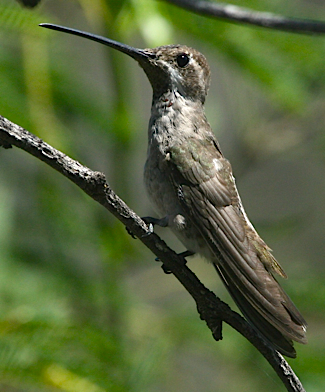
It may not be the
flashiest of hummingbirds, but the Plain-capped Starthroat
certainly was one of the biggest finds of the trip. The
one we found on our last day in the field was only about
the 20th record for the US! (Photo by guide Dave Stejskal)
MEXICAN WHIP-POOR-WILL (Caprimulgus arizonae arizonae)
Apodidae (Swifts)
WHITE-THROATED SWIFT (Aeronautes saxatalis)
Trochilidae (Hummingbirds)
MAGNIFICENT HUMMINGBIRD (Eugenes fulgens)
PLAIN-CAPPED
STARTHROAT (Heliomaster
constantii)
BLUE-THROATED
HUMMINGBIRD (Lampornis
clemenciae)
BLACK-CHINNED
HUMMINGBIRD (Archilochus
alexandri)
ANNA'S HUMMINGBIRD
(Calypte anna)
COSTA'S
HUMMINGBIRD (Calypte costae)
BROAD-TAILED
HUMMINGBIRD (Selasphorus
platycercus)
BROAD-BILLED
HUMMINGBIRD (Cynanthus
latirostris)
VIOLET-CROWNED
HUMMINGBIRD (Amazilia
violiceps)
Trogonidae (Trogons)
ELEGANT TROGON (Trogon elegans)
Picidae (Woodpeckers)
ACORN WOODPECKER (Melanerpes formicivorus)
GILA WOODPECKER
(Melanerpes uropygialis)
LADDER-BACKED
WOODPECKER (Picoides scalaris)
[N]
HAIRY WOODPECKER
(Picoides villosus)
ARIZONA WOODPECKER
(Picoides arizonae)
NORTHERN FLICKER
(RED-SHAFTED) (Colaptes
auratus cafer)
GILDED FLICKER
(Colaptes chrysoides)
Tyrannidae (Tyrant Flycatchers)
NORTHERN BEARDLESS-TYRANNULET (Camptostoma imberbe)
OLIVE-SIDED
FLYCATCHER (Contopus cooperi)
[b]
GREATER PEWEE
(Contopus pertinax)
WESTERN WOOD-PEWEE
(Contopus sordidulus)
WILLOW FLYCATCHER
(Empidonax traillii) [b]
PACIFIC-SLOPE
FLYCATCHER (Empidonax
difficilis) [b]
CORDILLERAN
FLYCATCHER (Empidonax
occidentalis)
BUFF-BREASTED
FLYCATCHER (Empidonax
fulvifrons)
BLACK PHOEBE
(Sayornis nigricans)
SAY'S PHOEBE
(Sayornis saya) [N]
VERMILION
FLYCATCHER (Pyrocephalus
rubinus)
DUSKY-CAPPED
FLYCATCHER (Myiarchus
tuberculifer)
ASH-THROATED
FLYCATCHER (Myiarchus
cinerascens)
BROWN-CRESTED
FLYCATCHER (Myiarchus
tyrannulus)
SULPHUR-BELLIED
FLYCATCHER (Myiodynastes
luteiventris)
TROPICAL KINGBIRD
(Tyrannus melancholicus)
CASSIN'S KINGBIRD
(Tyrannus vociferans)
THICK-BILLED
KINGBIRD (Tyrannus
crassirostris)
WESTERN KINGBIRD
(Tyrannus verticalis)
Laniidae (Shrikes)
LOGGERHEAD SHRIKE (Lanius ludovicianus)
Vireonidae (Vireos)
BELL'S VIREO (Vireo bellii)
PLUMBEOUS VIREO
(Vireo plumbeus) [N]
CASSIN'S VIREO
(Vireo cassinii) [b]
HUTTON'S VIREO
(Vireo huttoni)
WARBLING VIREO
(Vireo gilvus)
Corvidae (Crows, Jays, and Magpies)
STELLER'S JAY (Cyanocitta stelleri)
WESTERN SCRUB-JAY
(Aphelocoma californica)
MEXICAN JAY
(Aphelocoma wollweberi)
CHIHUAHUAN RAVEN
(Corvus cryptoleucus) [N]

The cascading
song of the Canyon Wren is one of the most unforgettable
sounds of the southwest. This bird gave us a fine
performance as it sat right next to the road and sang!
(Photo by guide Dave Stejskal)
COMMON RAVEN (Corvus corax)
Alaudidae (Larks)
HORNED LARK (Eremophila alpestris)
Hirundinidae (Swallows)
NORTHERN ROUGH-WINGED SWALLOW (Stelgidopteryx serripennis)
VIOLET-GREEN
SWALLOW (Tachycineta
thalassina)
BARN SWALLOW
(Hirundo rustica)
CLIFF SWALLOW
(Petrochelidon pyrrhonota)
Paridae (Chickadees and Tits)
MOUNTAIN CHICKADEE (Poecile gambeli)
MEXICAN CHICKADEE
(Poecile sclateri)
BRIDLED TITMOUSE
(Baeolophus wollweberi)
JUNIPER TITMOUSE
(Baeolophus ridgwayi)
Remizidae (Penduline-Tits)
VERDIN (Auriparus
flaviceps) [N]
Aegithalidae (Long-tailed Tits)
BUSHTIT (Psaltriparus
minimus)
Sittidae (Nuthatches)
RED-BREASTED NUTHATCH (Sitta canadensis)
WHITE-BREASTED
NUTHATCH (Sitta carolinensis)
PYGMY NUTHATCH
(Sitta pygmaea)
Certhiidae (Treecreepers)
BROWN CREEPER (Certhia americana)
Troglodytidae (Wrens)
CACTUS WREN (Campylorhynchus brunneicapillus)
ROCK WREN (Salpinctes obsoletus)
CANYON WREN
(Catherpes mexicanus)
BEWICK'S WREN
(Thryomanes bewickii)
HOUSE WREN
(Troglodytes aedon)
Polioptilidae (Gnatcatchers)
BLUE-GRAY GNATCATCHER (Polioptila caerulea)
BLACK-TAILED
GNATCATCHER (Polioptila
melanura)
Turdidae (Thrushes and Allies)
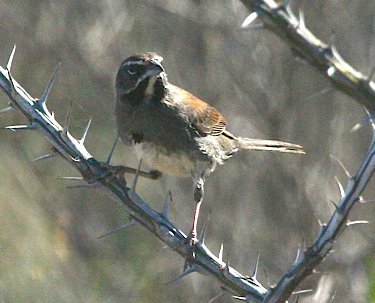
We got lucky with
the local Five-striped Sparrow this trip, finding one
right next to the road, saving us a long, hot hike. (Photo
by guide Dave Stejskal)
EASTERN BLUEBIRD (Sialia sialis)
SWAINSON'S THRUSH
(Catharus ustulatus) [b]
HERMIT THRUSH
(Catharus guttatus)
AMERICAN ROBIN
(Turdus migratorius)
Mimidae (Mockingbirds and Thrashers)
NORTHERN MOCKINGBIRD (Mimus polyglottos)
CURVE-BILLED
THRASHER (Toxostoma
curvirostre)
CRISSAL THRASHER
(Toxostoma crissale)
Sturnidae (Starlings)
EUROPEAN STARLING (Sturnus vulgaris) [I]
Ptilogonatidae (Silky-flycatchers)
PHAINOPEPLA (Phainopepla nitens)
Peucedramidae (Olive Warbler)
OLIVE WARBLER (Peucedramus taeniatus)
Parulidae (New World Warblers)
LUCY'S WARBLER (Oreothlypis luciae)
COMMON
YELLOWTHROAT (Geothlypis
trichas)
YELLOW WARBLER
(Setophaga petechia)
YELLOW-RUMPED
WARBLER (Setophaga coronata)
GRACE'S WARBLER
(Setophaga graciae)
BLACK-THROATED
GRAY WARBLER (Setophaga
nigrescens)
WILSON'S WARBLER
(Cardellina pusilla) [b]
RED-FACED WARBLER
(Cardellina rubrifrons)
PAINTED REDSTART
(Myioborus pictus)
YELLOW-BREASTED
CHAT (Icteria virens)
Emberizidae (Buntings, Sparrows and
Allies)
SPOTTED TOWHEE (Pipilo maculatus)
RUFOUS-CROWNED
SPARROW (Aimophila ruficeps)
CANYON TOWHEE
(Melozone fusca)
ABERT'S TOWHEE
(Melozone aberti)
RUFOUS-WINGED
SPARROW (Peucaea carpalis)
BOTTERI'S SPARROW
(Peucaea botterii)
CHIPPING SPARROW
(Spizella passerina)
BLACK-CHINNED
SPARROW (Spizella atrogularis)
LARK SPARROW
(Chondestes grammacus)
FIVE-STRIPED
SPARROW (Amphispiza
quinquestriata)
BLACK-THROATED
SPARROW (Amphispiza bilineata)
LARK BUNTING
(Calamospiza melanocorys) [b]
GRASSHOPPER
SPARROW (Ammodramus
savannarum)
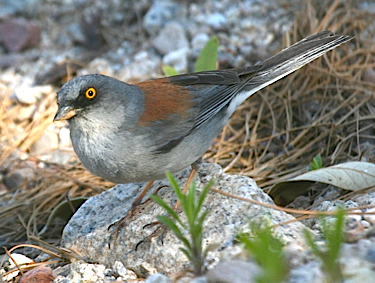
Another local
specialty, Yellow-eyed Junco, got our tour off to a good
start on our first day up on Mt Lemmon. (Photo by guide
Dave Stejskal)
SONG SPARROW (Melospiza melodia)
LINCOLN'S SPARROW
(Melospiza lincolnii) [b]
WHITE-CROWNED
SPARROW (MOUNTAIN) (Zonotrichia
leucophrys oriantha) [b]
YELLOW-EYED JUNCO
(Junco phaeonotus) [N]
Cardinalidae (Cardinals and Allies)
HEPATIC TANAGER (Piranga flava)
SUMMER TANAGER
(Piranga rubra)
WESTERN TANAGER
(Piranga ludoviciana) [N]
NORTHERN CARDINAL
(Cardinalis cardinalis)
PYRRHULOXIA
(Cardinalis sinuatus)
ROSE-BREASTED
GROSBEAK (Pheucticus
ludovicianus) [b]
BLACK-HEADED
GROSBEAK (Pheucticus
melanocephalus)
BLUE GROSBEAK
(Passerina caerulea)
LAZULI BUNTING
(Passerina amoena) [b]
VARIED BUNTING
(Passerina versicolor)
Icteridae (Troupials and Allies)
RED-WINGED BLACKBIRD (Agelaius phoeniceus)
EASTERN MEADOWLARK
(LILIAN'S) (Sturnella magna
lilianae)
YELLOW-HEADED
BLACKBIRD (Xanthocephalus
xanthocephalus)
[b]
GREAT-TAILED
GRACKLE (Quiscalus mexicanus)
BRONZED COWBIRD
(Molothrus aeneus)
BROWN-HEADED
COWBIRD (Molothrus ater)
ORCHARD ORIOLE
(Icterus spurius) [b]
HOODED ORIOLE
(Icterus cucullatus)
BULLOCK'S ORIOLE
(Icterus bullockii)
BALTIMORE ORIOLE
(Icterus galbula)
[b]
SCOTT'S ORIOLE
(Icterus parisorum)
Fringillidae (Siskins, Crossbills, and
Allies)
HOUSE FINCH (Carpodacus mexicanus)
LESSER GOLDFINCH
(Spinus psaltria)
Passeridae (Old World Sparrows)
HOUSE SPARROW (Passer domesticus) [I]
EASTERN COTTONTAIL
(Sylvilagus floridanus)
DESERT COTTONTAIL
(Sylvilagus audubonii)
BLACK-TAILED
JACKRABBIT (Lepus
californicus)
CLIFF CHIPMUNK
(Tamias dorsalis)
ROCK SQUIRREL
(Spermophilus variegatus)
ROUND-TAILED
GROUND SQUIRREL (Spermophilus
tereticaudus)
NAYARIT FOX
SQUIRREL (Sciurus
nayaritensis)
BOTTAE'S POCKET
GOPHER (Thomomys bottae)
YELLOW-NOSED
COTTON RAT (Sigmodon
ochrognathus)
ARIZONA COTTON RAT
(Sigmodon arizonae)
GRAY FOX (Urocyon cinereoargenteus)
COYOTE (Canis latrans)
COLLARED PECCARY
(Tayassu tajacu)
MULE DEER (Odocoileus hemionus)
WHITE-TAILED DEER
(Odocoileus virginianus)
PRONGHORN (Antilocapra americana)
Totals for the tour: 202 bird taxa and 16 mammal taxa








